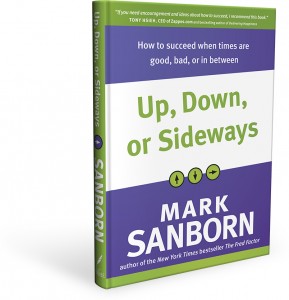 Since writing The Fred Factor about an extraordinary postal carrier named Fred Shea, I’ve encountered and learned about many other “Freds” who embrace the same spirit of service. I came across one such Fred while researching my latest book, Up, Down, or Sideways. It so happens, this one is literally, as well as figuratively, a Fred.
Since writing The Fred Factor about an extraordinary postal carrier named Fred Shea, I’ve encountered and learned about many other “Freds” who embrace the same spirit of service. I came across one such Fred while researching my latest book, Up, Down, or Sideways. It so happens, this one is literally, as well as figuratively, a Fred.
Fred Johnson had lived in New Orleans for nearly six decades, and he wasn’t the type to sit around and do nothing when people throughout his city were suffering. So in 2005, after Hurricane Katrina overwhelmed the levee system that protected much of New Orleans from the Gulf of Mexico’s waters, Johnson made his way to the Superdome, where thousands of people had gathered in search of shelter from the storm.
The Superdome lacked the security, clean water, food, and bedding needed for a crisis of this magnitude. Nearly all the people there had lost their homes. Chaos, confusion, and uncertainty filled the air as the multitudes struggled to find information about where to go and how to get there, not to mention about who among their friends and family had survived and who had not.
The suffering overwhelmed Johnson. In fact, he later told Scientific American magazine that he “lost it” for a brief period when he first arrived on the scene. Then, he said, his “governor” kicked in.
“When I become overwhelmed,” he said, “I think my process is this: I’m going to cry about it, I’m going to dry my eyes, and then I’m going back to work, but I’m not going to keep crying, crying, crying. I think that’s my governor. That’s how I keep my sanity.”
Johnson, you see, is an optimist. That doesn’t mean he saw happy opportunity and niceness in the midst of one of America’s worst natural disasters. It means he had the ability to quickly re-orient his view of the situation so that he could help himself and help others.
Real optimism like Johnson’s isn’t blind faith; it is far-sighted faith. Rather than deny the problems of the present, it focuses on the solutions for the future. It doesn’t look at the world through rose-tinted glasses; it uses trifocals — accepting the good, the bad, and the in-between, but choosing to focus on the good.
The negative person focuses only on the downside. The realist sees the downsides and the upsides but is uncertain about where to focus. The intelligent optimist doesn’t ignore the downside or reality, but simply focuses on the upside and expects the best.
This blog is based on content in my latest book, Up, Down, Or Sideways. It is available wherever you buy great books. Click here to learn more about the book or click here to order it from Amazon.com.









Love this post, Mark! Keeps everything in perspective. I can’t wait for the book…
“it uses trifocals — accepting the good, the bad, and the in-between, but choosing to focus on the good.”
Am positive that reading Up, Down, or Sideways will help to equip all of us with the appropriate trifocals and thereby enable us to focus mainly on the good.
Thank you!
Geetha
“Governor,” a capital idea
Mark Sanborn’s philosophies, mentality, and expertise inspired me when I read “The Fred Factor”, “You Don’t Need a Title to Be a Leader”, and “The Encore Effect”. With his new book, “Up, Down, or Sideways – How to Succeed when times are good, bad, or in between”, I’m left with a feeling of HOPE…in a time when hope is certainly not at the forefront of the minds of many Americans and citizens of the world. Between 2008 and 2010, I lost my job twice, had to move three times to three different cities, and finally found work. I can relate to Mark’s wisdom and lessons from the book, but I can’t help but think that so many others like me, who have been up, down, AND sideways recently, will walk away with a feeling of HOPE and INSPIRATION from reading this book. I recommend not only reading it, but also passing it along, suggesting it to your teams, coworkers, friends, and family.